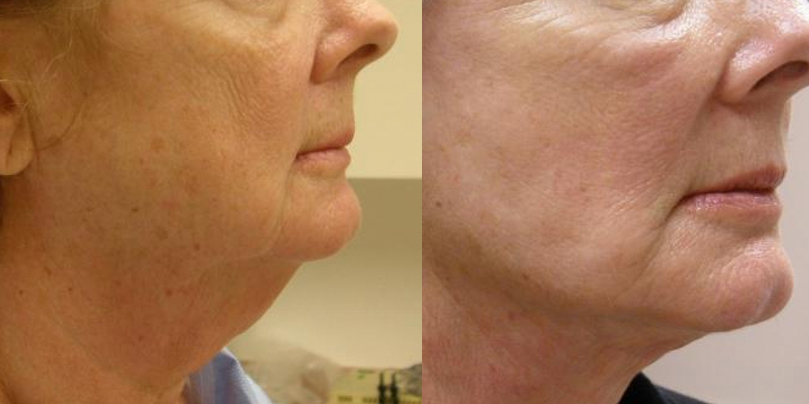Top Six Questions to Ask About Facelift
February 21, 2012
Robert Langdon, MD
The Langdon Center for Laser and Cosmetic Surgery
The techniques used for face lift surgery vary widely and it can be difficult for prospective patients to choose which variant of face lift is right for them. It is important to know the answers to these six questions when evaluating different types of face lifts.
*Individual Results May Vary
1. Will a minimal incision be used?
A: The main advantage of a minimal incision is decreased visibility of scarring. The goal should be no noticeable scar to the casual observer. The minimal incision is made just in front of and within the ear, within the lower hairline of the sideburn and just behind the lower earlobe. In contrast, the traditional face lift incision extends higher in the temple and, even worse, in the scalp behind the ear. The behind-the-ear area is the most obvious scar and can be very visible when the hair is worn up.
In the Express-Lift, deep plane undermining (see Question 4 below) and tightening of the fascia in multiple directions enables significant improvement in gravitational sagging of the neck and lower face; all of this is achieved through a minimal skin incision.
2. What type of anesthesia will be used?
A: A facelift should be performed under local anesthesia for maximal safety and the quickest recovery. The local anesthetic contains a medication that constricts the blood vessels, thus greatly reducing bruising. Reduced bruising results in less swelling and a quicker recovery. A sedative will help relax the patient.
A tumescent type local anesthetic also increases safety because it expands the tissue, thus decreasing the risk of injury of underlying nerves.
3. Will liposuction of the neck and jowls also be done?
A: Liposuction, especially of the neck, greatly enhances the results of a facelift. Most people accumulate significant fat in the neck beneath the chin. Reducing this fat by liposuction improves the neck contour and stimulates tightening of the skin. The sagging muscle/fascia layer (see Question 4 below) of the neck is then tightened as part of the facelift.
The jowls are the part of the lower cheek just lateral to (outside of) the chin. There is a distinct fat pad underneath the skin in this area, causing the jowls to bulge. This relative increased volume, along with sagging due to gravity, causes the jowl to hang over (below) the jaw line, which interrupts the ideal straight line of the jaw. A sagging jowl also increases the perceived depth of the marionette fold (pre-jowl sulcus), the furrow between the chin and the jowl. Liposuction can reduce the fullness of the jowl; however, substantial improvement of a sagging jowl requires tightening of the underlying fascia (see Question 4 below).
Facelift Consultations Available
If you have further questions about facelift, we encourage you to schedule a consultation at The Langdon Center in Guilford, CT. Call us at 203-453-8625 or fill out our convenient online contact form.
4. Is the fascia (SMAS) mobilized (loosened so that it can be shifted in position)?
A: Long-term improvement in gravitational sagging of the face requires that the fascia, a connective tissue layer that lies beneath the subcutaneous fat, be lifted in an upward direction. This vertical vector of lifting counteracts the downward sagging caused by many years of living under the influence of gravity. The essence of modern face lift surgery is shifting the position of the fascia of the face (also referred to as the Superficial Musculo-Aponeurotic System, SMAS). The SMAS is a layer of connective tissue that varies in thickness in different parts of the face; it is in direct continuity with most of the superficial muscles whose contraction creates facial expressions. Vertical bands of connective tissue attach the overlying skin to the SMAS, enabling the overlying skin to move along with the muscles. In a few distinct locations, the SMAS is also attached to the underlying bones of the skull.
The most sophisticated face lift techniques include loosening the underlying attachments of the SMAS, especially those to the bone, in order to increase mobility of the fascia. The layer beneath the SMAS is referred to as the “deep plane;” such surgeries are called deep plane face lifts. The mobilized SMAS can be shifted more easily, and will heal by attaching to underlying structures, thus affording long-term improvement after the face lift.
5. How long does it take to do the procedure?
A: Avoid any face lift (such as the heavily promoted “Lifestyle Lift”) that supposedly is done in “about an hour.” This brief period may be adequate for obtaining a new pair of eyeglasses, but is not nearly enough for a satisfactory face lift. I have seen several patients who were disappointed after undergoing a Lifestyle Lift because the degree of improvement was minimal. It takes much longer (four or more hours) to accomplish the required undermining, mobilizing and suspending the fascia, trimming of excess skin and precise placement of stitches in the skin to achieve substantial improvement from a face lift.
6. How long is the expected recovery period after the face lift?
A: The key to a quick recovery is the type of anesthesia that is used for the face lift. Tumescent local anesthetic completely numbs the area of surgery and includes epinephrine, a medication that shrinks the blood vessels during the surgery, thus minimizing bruising. Less bruising results in less swelling and a quicker recovery. After an Express-Lift, most patients are presentable by one week, the time at which surface stitches are removed.
This article is written and copyrighted by Robert Langdon, MD. You are welcome to link to this page or put this article on your website as long as you do not change it’s contents and as long as you give the Langdon Center credit with a live clickable link to langdonrstg2.wpengine.com.
Dr. Langdon and all of his nurses and staff are very friendly and they know how to make you feel very comfortable. He is a very experienced doctor, I call him an artistic dr. because he’s so precise in his work. If you would like something done right, dr. Langdon is the one to see. I am very pleased with my results and very grateful for him and his staff being here in Ct.
Take the Next Step
If you have further questions about facelift, we encourage you to schedule a consultation at The Langdon Center in Guilford, CT. Call us at (203) 453-8625 or fill out our convenient online contact form.








